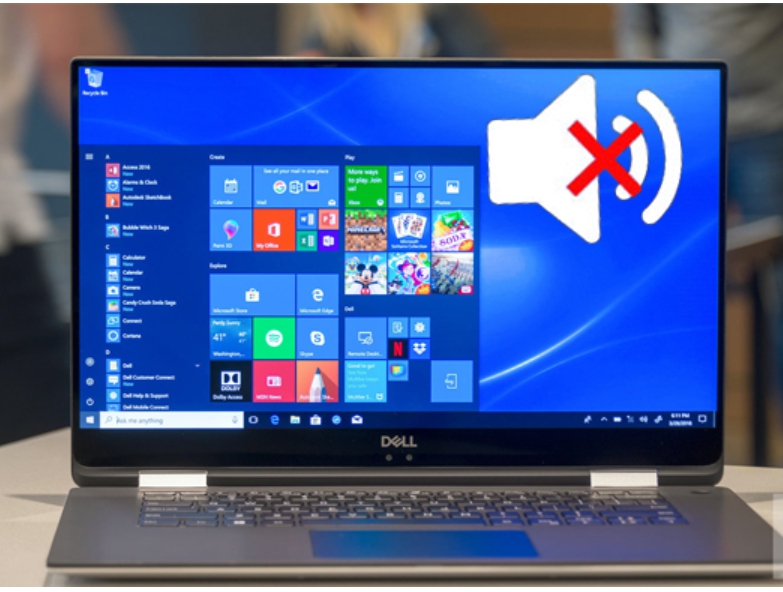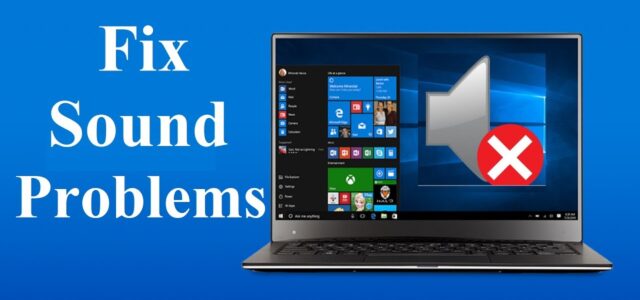Laptops are made of many components, all of which must work together correctly to make a fully functional system. One of the major components is the laptop speaker. See what to do when your laptop speakers are not working?
Sure, you can always use external Bluetooth headsets or stereo speakers, but do you really have to?
You paid for your laptop speakers, and you should be able to listen to sound on your computer without having to connect an external speaker.

In this post, we’ll help you actualize that right. You’ll learn how to troubleshoot faulty laptop speakers and some things you can do to get your computer’s sound system working again.
Post Content
Why Are My Laptop Speakers Not Working?
For any device to work with your computer, there are many hardware and software jamboree going on under the hood.
All of these processes must work perfectly to have a working peripheral. The same is the case with your laptop speakers.
When your laptop speakers stop working, it may be a result of a hardware failure. Normally, you can’t fix this yourself, and you’ll have to take your computer to a repair technician.
However, software issues are usually easier to fix, and fortunately more widespread. If your laptop speakers stop working, it is most likely a software issue.
Software problems that might affect your speakers include incorrect drivers and incorrect settings. In fact, you may have unknowingly put your speakers on mute.
Before seeing a repair technician for a possible hardware failure, you should try all of the fixes we’ll discuss in this article to get your laptop speakers working again.
How to Fix Laptop Speakers Not Working – The Solution
It’s always easier to fix a problem when you know the cause. However, not knowing the cause doesn’t make any problem unfixable.
In this section, we’ll list some of the fixes that have worked for others, and should probably work for you too.
- Run the audio troubleshooter
When you’re having any problem with your laptop’s sound, the first step you should take is running the Audio troubleshooter.
To some degree of accuracy, the Audio troubleshooter fishes out most of the problems with your computer’s audio and tries to fix them. Even if it doesn’t succeed in fixing them, it gives you some insight into what to do in order to fix the problem.
The Audio troubleshooter is hidden away in the Windows Settings. Here is how to find and run the troubleshooter to diagnose what is wrong with your Windows laptop sound.
- Open Settings. You can press the Win + I key combination to open the Settings app on your Windows 10 computer. Otherwise, press the Start button and click on the Settings icon just over the Power icon.
- Click on System and then Sound. To the right of the windows, you should see the Troubleshoot button with a danger icon.
- Click the Troubleshoot button and wait for the troubleshooting process to finish.
After troubleshooting, the audio troubleshooter will give you a report after completing the operation. It may be that you just muted your computer!
- Reinstall or update the sound drivers
More often than not, incorrect drivers are the cause of your laptop’s audio issues. Correct and up-to-date drivers are necessary for the computer to reliably interface with the laptop speakers.
When your laptop audio drivers get tampered with by Windows updates or some other programs, your speakers may stop working correctly, or at all.
In this case, you may need to reinstall or update your audio drivers.
A word of advice: always try reinstallation before you try an update, updates frequently break devices.
Here is how to reinstall or update your laptop’s audio drivers.
- Open Control Panel, and then Device Manager. You can also open Device Manager directly by Win + X, and then M. This will bring up a list of all your devices, segmented by categories.
- Double click on ‘Sound, video, and game controllers.’ Uninstall every driver under this category. Restart your computer after uninstalling the drivers.
Your computer will reinstall all the uninstalled drivers with the factory versions. This should correct any problems caused by incorrect driver updates.
If your laptop’s speakers start working after the uninstallation and reinstallation, congratulations. However, if it doesn’t, you may want to update your drivers using the steps below.
- Open Device Manager as above, and double click on the ‘Sound, video and game controllers category.
- Right-click on each of the drivers in this category, and select update drivers. When Windows asks how you want to search for the drivers, select ‘Search automatically for updated driver software.’
- Wait for a few minutes for Windows to find the correct drivers for the speakers. If there are no available driver updates, Windows will notify you of the same.
If installing and reinstalling your drivers didn’t work for you, we have some extra fixes.
- Check your volume
It’s very possible that the fix to your audio problem is just a simple volume tweak. Your cat may have jumped on your keyboard, pressing the mute or volume down button. Getting back to work, you discover that your speakers don’t work anymore.
You made some Google searches, and you see very technical information. Your brain tells you that your laptop has a serious fault, and you believe it, poor you.
Before moving on, it’s a good idea to hover your mouse on the Sound icon in the System Tray. If it displays ‘Speakers: 100%,’ then move down to the next fix in this post.
Otherwise, turn your volume all the way up!
- Use an external audio device
While it hurts to know that your speakers are not working, you can still deal with it. If you have a good pair of headphones, you can always put them on when you have to use your laptop.
If you don’t like putting extra load on your ears like me, you can use an external speaker. If you have an external monitor with a speaker, you can connect it to your laptop to listen to any sound you want.
There are many good headsets, even better than your laptop’s speakers.
However, it’s always best to take your laptop to the technician, as your headsets may be absent on the day that you’ll need them the most.
- Disable audio enhancements
If you’ve set up any audio enhancements on your computer, you should disable all of them when your speaker starts behaving weirdly.
While it’s unlikely that this will be the solution to your laptop speaker problem, it doesn’t hurt to try.
Here is how to disable audio enhancements on a Windows 10 PC.
- Right-click on the sound icon from the System Tray and click on Sounds. This brings up a little Window with some tabs. Click on the playback tab to reveal all your connected audio devices.
- Right-click on the active audio device and select Properties from the context menu. Select the ‘Enhancements’ tab to reveal all the active enhancements for your speakers.
- Check the box that reads ‘Disable all sound effects.’ Click on Apply to apply the changes. If you don’t see the checkbox, you can manually disable all the active enhancements to see if your speakers are fixed already.
This should solve the problems you’re having if audio enhancements are the cause of the problem in the first place. But as I’ve said earlier, they’re probably not.
- Get technical help
If you’ve tried every fix in this article, the problem is most probably a hardware problem. While you could fix this yourself with guidance, you should never attempt to.
For one, you void your warranty once you try to repair anything yourself. Also, you can break something in the computer, and remember, you don’t have any warranty anymore.
When it’s almost certain that it’s a technical problem, you should get the computer to a certified technician as soon as possible.
If the laptop is still under warranty, you can get a free repair or replacement. Otherwise, you’ll have to pay to get your laptop speakers fixed.
It’s all worth it, judging by how often I need to use my laptop’s speakers.
MORE ARTICLES
How to Clean A Laptop Fan – Perfect Ways To Clean PC Fan
Computer Not Recognizing Headphones Windows 7, 10
Dell plugged in Not Charging Windows 10 -One Time Solution
HP Laptop Fan Always Running – How To Fix It
Headphones Not Working On Laptop – See What To Do
Best Processors for Mobile – Companies With Best Processors
Bluestacks for iPhone (Bluestacks for iOS)
List Of Best 144Hz Gaming Laptop Under $1000
Super Mario Sunshine Rom For GameCube Free Download
Android Emulator for iOS (iOS Android Emulator, Android Emulator iPhone)
Twitter Video Length Limit – How Long Can a Twitter Video Be?
Conclusion
Laptops are very compact computers that cram every essential component into one piece. When a part fails, your laptop starts to malfunction.
In this case, it’s the laptop speakers not working. There are many reasons why this could happen, and there are also many solutions to it if it does happen.
If any of our suggested fixes don’t work, we strongly suggest that you send your laptop in for repair.

